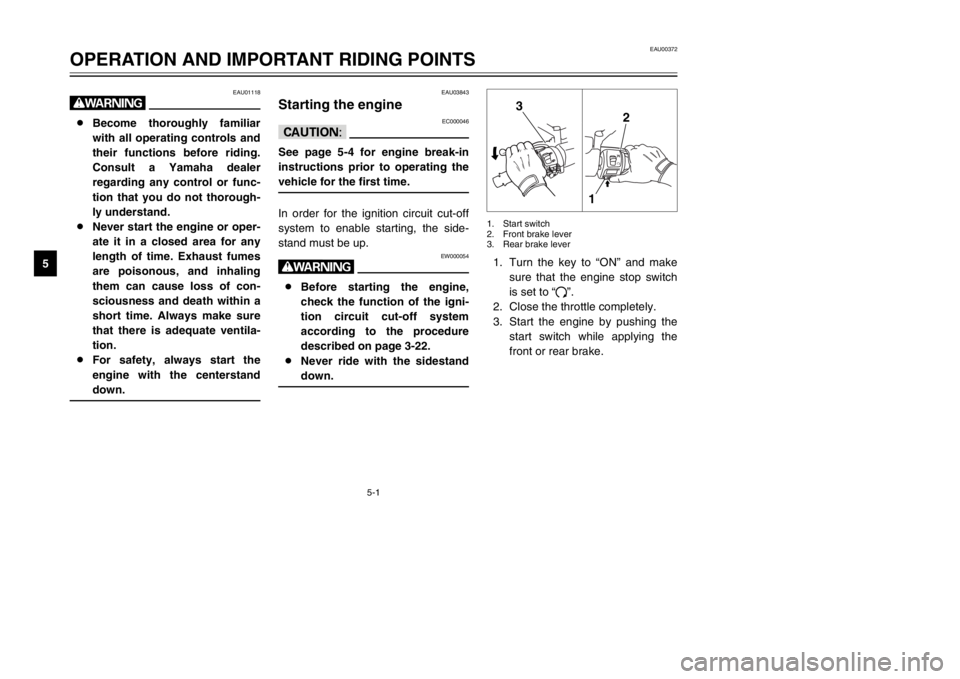Page 14 of 114
2-2
DESCRIPTION
2
9. Passenger seat
10. Rider seat (page 3-17)
11. Air flow louver (page 6-23)
12. Headlight (page 6-37)
13. Radiator 14. Battery (page 6-34)
15. Fuse box (page 6-36)
16. Coolant reservoir cap (page 6-19)
17. Coolant level check window (page 6-19)
18. Engine oil filler cap (page 6-15)
11
12
13 16 17
1815, 14
10
9
Right view
5SJ-28199-E0 1/24/02 6:14 PM Page 13
Page 18 of 114

3-2
INSTRUMENT AND CONTROL FUNCTIONS
3
EAU03733
.
(Parking)
The steering is locked, and the tail-
light, license light and auxiliary light
are on, but all other electrical sys-
tems are off. The key can be
removed.
To turn the main switch to “
.
”:
1. Turn the key to “LOCK”.
2. Slightly turn the key counter-
clockwise until it stops.
3. While still turning the key coun-
terclockwise, push it in until it
snaps into place.
ECA00043
cCDo not use the parking position for
an extended length of time, other-
wise the battery may discharge.
EAU03734
Oil change indicator light “
7
”
Oil change indicator lightThis indicator light comes on at the
initial 1,000 km and every 3,000 km
thereafter to indicate that the engine
oil should be changed.
If the engine oil is changed before the
oil change indicator comes on (i.e.
before the periodic oil change interval
has been reached), the indicator light
must be reset after the oil change for
the next periodic oil change to be
indicated at the correct time. (See
page 6-17 for the resetting proce-
dure.)
The electrical circuit of the indicator
light can be checked according to the
following procedure.
1. Set the engine stop switch to “#”
and turn the key to “ON”.
2. Check that the indicator comes
on for a few seconds and then
goes off.
3. If the indicator light does not
come on, have a Yamaha dealer
check the electrical circuit.
EAU00056
Indicator lightsIndicator lights
EAU04121
Turn signal indicator lights “4”
and “6”Turn signal indicator lightsThe corresponding indicator light
flashes when the turn signal switch is
pushed to the left or right.
EAU00063
High beam indicator light “&”High beam indicator lightThis indicator light comes on when
the high beam of the headlight is
switched on.
1
2
3
4
1. Left turn signal indicator light “4”
2. High beam indicator light “&”
3. Oil change indicator light “
7
”
4. Right turn signal indicator light “6”
5SJ-28199-E0 1/24/02 6:14 PM Page 17
Page 37 of 114
3-21
INSTRUMENT AND CONTROL FUNCTIONS
3
EAU00337
Ignition circuit cut-off
systemIgnition circuit cut-off systemThe ignition circuit cut-off system
(comprising the sidestand switch and
brake light switches) has the follow-
ing functions.
8It prevents starting when the
sidestand is up, but neither brake
is applied.
8It prevents starting when either
brake is applied, but the side-
stand is still down.
8It cuts the running engine when
the sidestand is moved down.
Periodically check the operation of
the ignition circuit cut-off system
according to the following procedure.
EW000045
wIf a malfunction is noted, have a
Yamaha dealer check the system
before riding.
5SJ-28199-E0 1/24/02 6:14 PM Page 36
Page 38 of 114
3-22
INSTRUMENT AND CONTROL FUNCTIONS
3
The sidestand switch may be defective.The scooter should not be ridden until
checked by a Yamaha dealer.
YES NO
With the engine turned off:
1. Move the sidestand down.
2. Make sure that the engine stop switch is set to “#”.
3. Turn the key to “ON”.
4. Keep the front or rear brake applied.
5. Push the start switch.
Does the engine start?
The brake switch may be defective.
The scooter should not be ridden until
checked by a Yamaha dealer.
With the engine still off:
6. Move the sidestand up.
7. Keep the front or rear brake applied.
8. Push the start switch.
Does the engine start?With the engine still running:
9. Move the sidestand down.
Does the engine stall?
The sidestand switch may be defective.
The scooter should not be ridden until
checked by a Yamaha dealer.NOTE:This check is most reliable if performed with
a warmed-up engine.
YES NO
The system is OK. The scooter can be ridden.
YES NO
5SJ-28199-E0 1/24/02 6:14 PM Page 37
Page 41 of 114

4-1
EAU01114
PRE-OPERATION CHECKS
4The condition of a vehicle is the owner’s responsibility. Vital components can start to deteriorate quickly and unexpect-
edly, even if the vehicle remains unused (for example, as a result of exposure to the elements). Any damage, fluid leak-
age or loss of tire air pressure could have serious consequences. Therefore, it is very important, in addition to a thor-
ough visual inspection, to check the following points before each ride.
EAU03439
Pre-operation check list
Pre-operation check list
ITEM CHECKS PAGE
Fuel•Check fuel level in fuel tank.
•Refuel if necessary.
•Check fuel line for leakage.3-4, 3-14–3-15
Engine oil•Check oil level in engine.
•If necessary, add recommended oil to specified level.
•Check vehicle for oil leakage.6-14–6-17
Final transmission oil•Check vehicle for oil leakage. 6-18–6-19
Coolant•Check coolant level in reservoir.
•If necessary, add recommended coolant to specified level.
•Check cooling system for leakage.3-5, 6-19–6-20
Front brake•Check operation.
•If soft or spongy, have Yamaha dealer bleed hydraulic system.
•Check lever free play.
•Adjust if necessary.
•Check fluid level in reservoir.
•If necessary, add recommended brake fluid to specified level.
•Check hydraulic system for leakage.3-12, 6-27–6-30
5SJ-28199-E0 1/24/02 6:14 PM Page 40
Page 45 of 114

5-1
EAU00372
OPERATION AND IMPORTANT RIDING POINTS
5
EAU01118
w8Become thoroughly familiar
with all operating controls and
their functions before riding.
Consult a Yamaha dealer
regarding any control or func-
tion that you do not thorough-
ly understand.
8Never start the engine or oper-
ate it in a closed area for any
length of time. Exhaust fumes
are poisonous, and inhaling
them can cause loss of con-
sciousness and death within a
short time. Always make sure
that there is adequate ventila-
tion.
8For safety, always start the
engine with the centerstand
down.
EAU03843
Starting the engineStarting the engine
EC000046
cCSee page 5-4 for engine break-in
instructions prior to operating the
vehicle for the first time.In order for the ignition circuit cut-off
system to enable starting, the side-
stand must be up.
EW000054
w8Before starting the engine,
check the function of the igni-
tion circuit cut-off system
according to the procedure
described on page 3-22.
8Never ride with the sidestand
down.
1. Turn the key to “ON” and make
sure that the engine stop switch
is set to “#”.
2. Close the throttle completely.
3. Start the engine by pushing the
start switch while applying the
front or rear brake.
3
2
1
1. Start switch
2. Front brake lever
3. Rear brake lever
5SJ-28199-E0 1/24/02 6:14 PM Page 44
Page 46 of 114
5-2
OPERATION AND IMPORTANT RIDING POINTS
5
NOTE:
If the engine does not start, release
the start switch, wait a few seconds,
and then try again. Each starting
attempt should be as short as possi-
ble to preserve the battery. Do not
crank the engine more than 10 sec-
onds on any one attempt. If the
engine does not start, try with the
throttle open 1/8 turn.
ECA00045
cCFor maximum engine life, never
accelerate hard when the engine is
cold!
4. Check for oncoming traffic, and
then slowly turn the throttle grip
(on the right) in order to take off.
5. Switch the turn signal off.
EAU00433
Starting offStarting offNOTE:
Before starting off, allow the engine
to warm up.1. While pulling the rear brake lever
with your left hand and holding
the grab bar with your right hand,
push the scooter off the center-
stand.
2. Sit astride the seat, and then
adjust the rear view mirrors.
3. Switch the turn signal on.
1
1. Grab bar
5SJ-28199-E0 1/24/02 6:14 PM Page 45
Page 48 of 114

5-4
OPERATION AND IMPORTANT RIDING POINTS
5
EAU03093
Tips for reducing fuel
consumptionFuel consumption, tips for reducingFuel consumption depends largely on
your riding style. Consider the follow-
ing tips to reduce fuel consumption:
8Thoroughly warm up the engine.
8Avoid high engine speeds during
acceleration.
8Avoid high engine speeds with
no load on the engine.
8Turn the engine off instead of let-
ting it idle for an extended length
of time (e.g., in traffic jams, at
traffic lights or at railroad cross-
ings).
EAU01128
Engine break-inEngine break-inThere is never a more important peri-
od in the life of your engine than the
period between 0 and 1,600 km. For
this reason, you should read the fol-
lowing material carefully.
Since the engine is brand new, do
not put an excessive load on it for the
first 1,600 km. The various parts in
the engine wear and polish them-
selves to the correct operating clear-
ances. During this period, prolonged
full-throttle operation or any condition
that might result in engine overheat-
ing must be avoided.
EAU04590
0–1,000 km
Avoid prolonged operation above
4,000 r/min.
1,000–1,600 km
Avoid prolonged operation above
5,000 r/min.
ECA00138
cCAfter 1,000 km of operation, be
sure to replace the engine oil and
final transmission oil.1,600 km and beyond
The vehicle can now be operated
normally.
ECA00137
cC8Keep the engine speed below
8,500 r/min.
8If any engine trouble should
occur during the engine break-
in period, immediately have a
Yamaha dealer check the vehi-
cle.
5SJ-28199-E0 1/24/02 6:14 PM Page 47